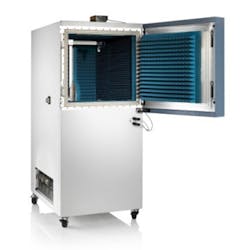Among the millions of words written and spoken about 5G, “easy” might well be the rarest. The reason, of course, is that it’s mindbogglingly difficult, even for the experts at National Instruments, Keysight, Anritsu, Intel, Qualcomm, and anyone else that has been preparing for it for years.
Of course, that doesn’t mean it won’t get easier, and Rohde & Schwarz is aiming to do just that with its ATS1000, a new over-the-air (OTA) test chamber it announced at Mobile World Congress (see figure). R&S claims it’s the first such test chamber for 5G. I’d challenge them on that claim, as might octoScope with its <6-GHz and mmWave octoBox, and Emite with its PT-Series <6-GHz reverberation chamber.
However, the point is that R&S is stepping up to meet one of the greatest challenges of 5G: performing OTA testing of 5G devices. This is already being done at <6 GHz, but at 28 GHz and above, a number of things happen.
First, there’s already a move away from conducted tests, even at <6 GHz, primarily because of the number of antennas that need to be connected as devices increasingly incorporate MIMO and now multi-user MIMO (MU-MIMO), that’s part of 5G.
Rohde & Schwarz made its ATS1000 5G OTA test chamber public at MWC 2018, which it will use as a springboard to more economic and faster 5G device test. (Source: Rohde & Schwarz)
Secondly, at mmWave frequencies, the Friis equation looms large: It shows that in free space, received power at the antenna is inversely proportional to the square of the distance from the transmitting antenna. In short, it takes a lot more power to transmit at a specified data rate over a given distance, with a single antenna. The single antenna part is important. As with multiple-antenna arrays, or phased-array antennas (PAAs) at the transmitter and receiver, more of the transmitted signal can be captured, thereby reducing the required transmit power, theoretically.
The problem is that multiple antennas need space, power, and excellent on-board isolation per channel. They also need to be modeled better in free space, both per-channel as well as in concert, and under varying conditions—including human body simulations—as the body’s specific absorption rate (SAR) varies with frequency.
That the new PAAs need to be tested more thoroughly is a given, with 5G’s enormous jump in data rates and spectral efficiency requirements, and the many unknowns associated with PAAs in mobile devices. The real problem is that it’s just not feasible to do conducted tests—there literally isn’t enough space for the connectors.
So, OTA tests must be done, which requires a controlled environment to avoid interference on test signals. Typically, this means sending a device to a test lab to be placed in a large anechoic chamber and then have the device sent back with the results. If it fails, make the fix, and repeat.
R&S Gets Personal
Test is difficult and expensive enough as it is, without having to spend days going back and forth to a lab. So, R&S’s idea is to bring the test chamber to the designer or manufacturing site for production test. That way, the designer or manufacturing facility can do tests and make adjustments in real time, making coexistence testing, channel modeling, and near- and far-field antenna pattern testing a lot quicker to perform.
The idea of a personal test chamber isn’t new: octoScope and Emite have been providing “personal test beds” for some time. What’s different about R&S’s new system is that it’s R&S’s first such system (a major vendor), and that it operates over the mmWave bands, starting at 18 GHz, all the way up to 87 GHz, with >50-dB shielding.
Emite’s system is aimed at <6-GHz test (690 MHz to 6 GHz) and octoScope’s octoBox-5G covers 24 to 86 GHz, though it also supports <6-GHz testing. In addition, octoBox-5G has a rotating table to test devices over a full 360˚ change in orientation.
That said, there are more similarities than differences, with the beneficiary being designers looking to perform 5G device test more quickly and cost-effectively, at least for relatively large design and manufacturing houses. It may be a bit expensive for a garage shop.
OTA testing is just one of the many challenges ahead for device designers. Others include lowering the cost and power consumption of MU-MIMO implementations; testing across multiple domains, from RF to baseband to the core network; modeling the 5G NR waveforms; negotiating the various physical-layer (PHY) complexities; and handling dynamic behaviors with network emulation.
All of these will be addressed here on Test.Pass in the coming years. Just today, I got my personally inscribed and delivered invite to NI Week in May. NI’s been doing 5G R&D since the dawn of this millennium. I look forward to seeing where they’re at now—and to seeing you there!
About the Author
Patrick Mannion
Founder and Managing Director
Patrick Mannion is Founder and Managing Director of ClariTek, LLC, a high-tech editorial services company. After graduating with a National Diploma in Electronic Engineering from the Dundalk Institute of Technology, he worked for three years in the industry before starting a career in b2b media and events. He has been covering the engineering, technology, design, and the electronics industry for 25 years. His various roles included Components and Communications Editor at Electronic Design and more recently Brand Director for UBM's Electronics media, including EDN, EETimes, Embedded.com, and TechOnline.


